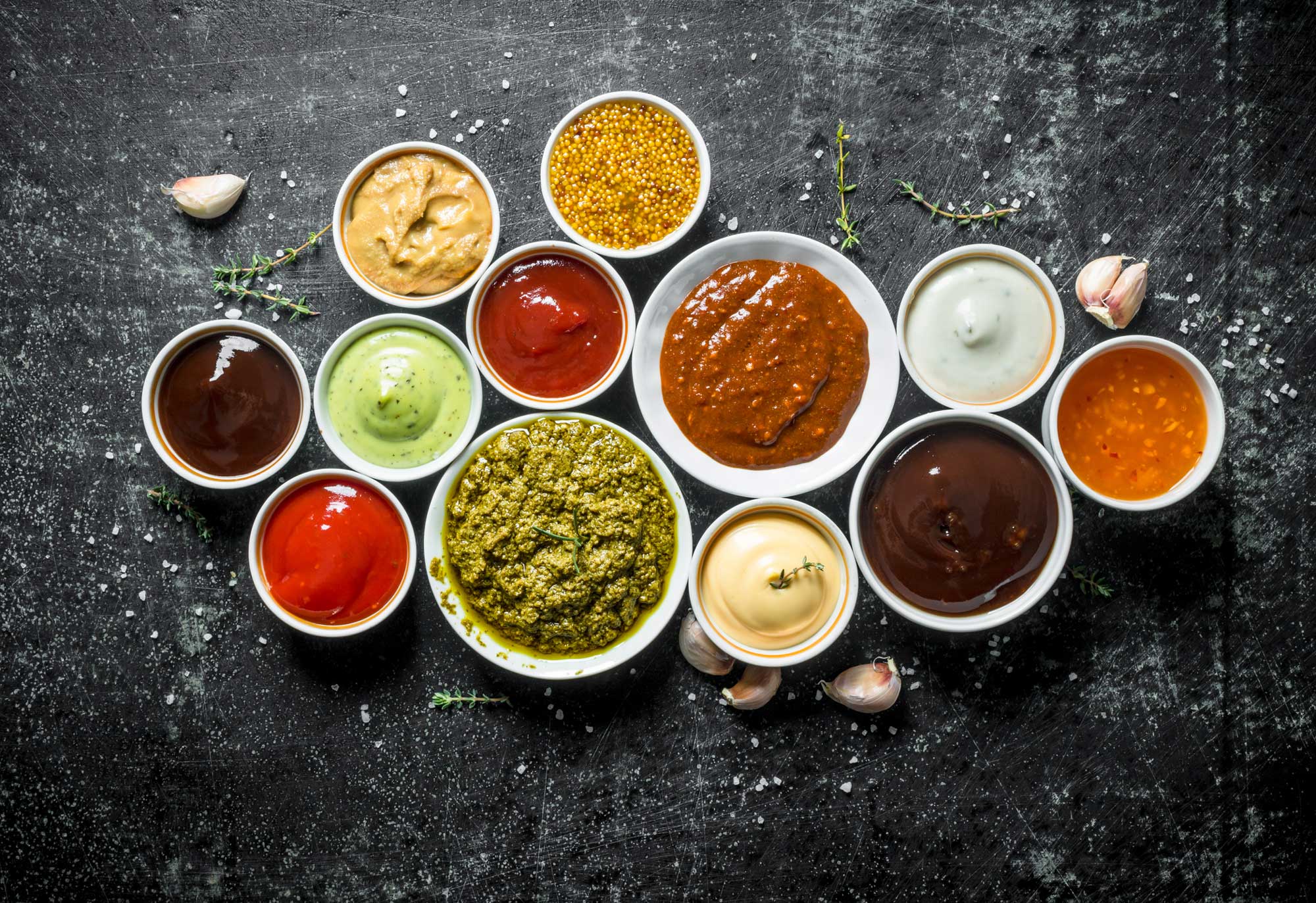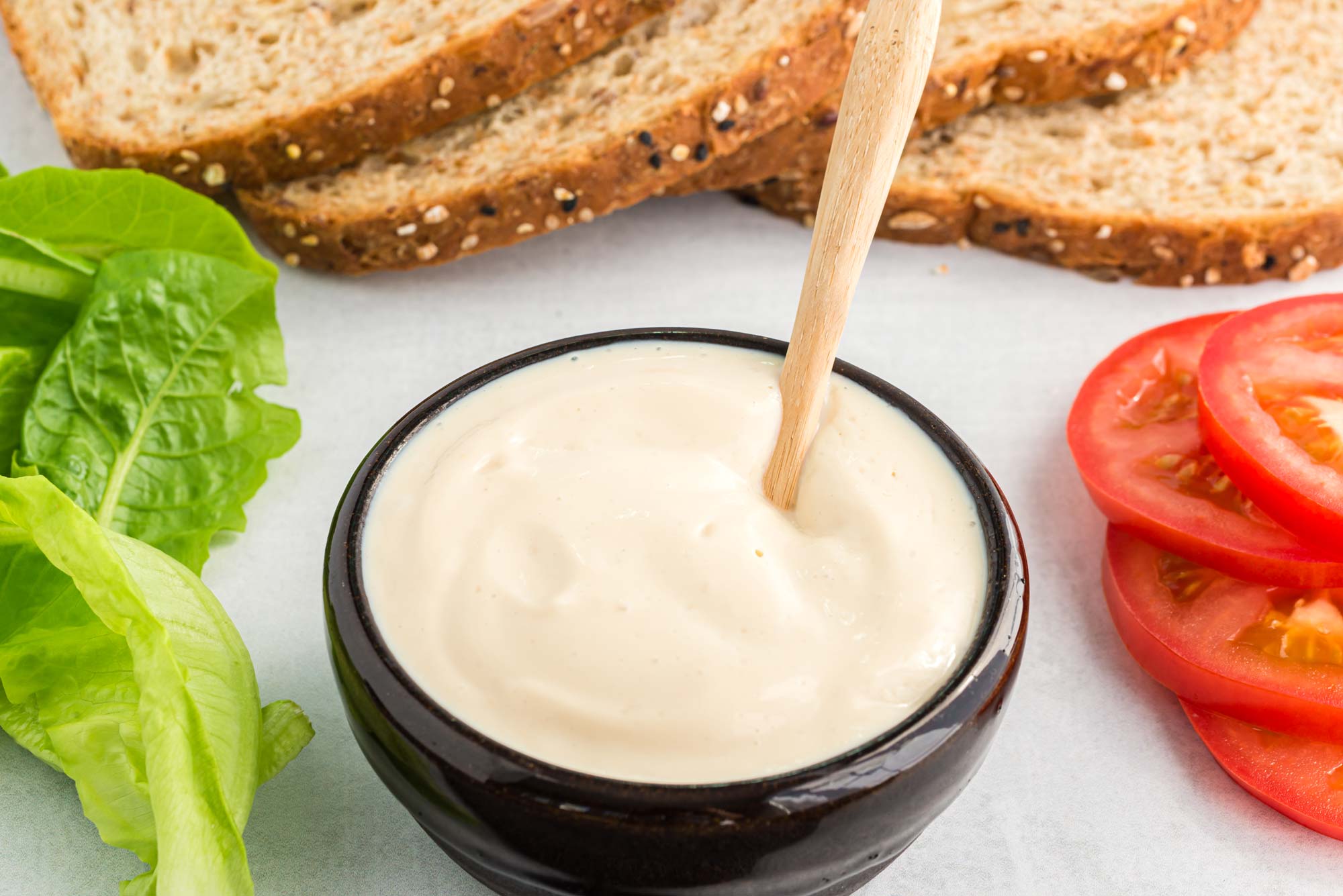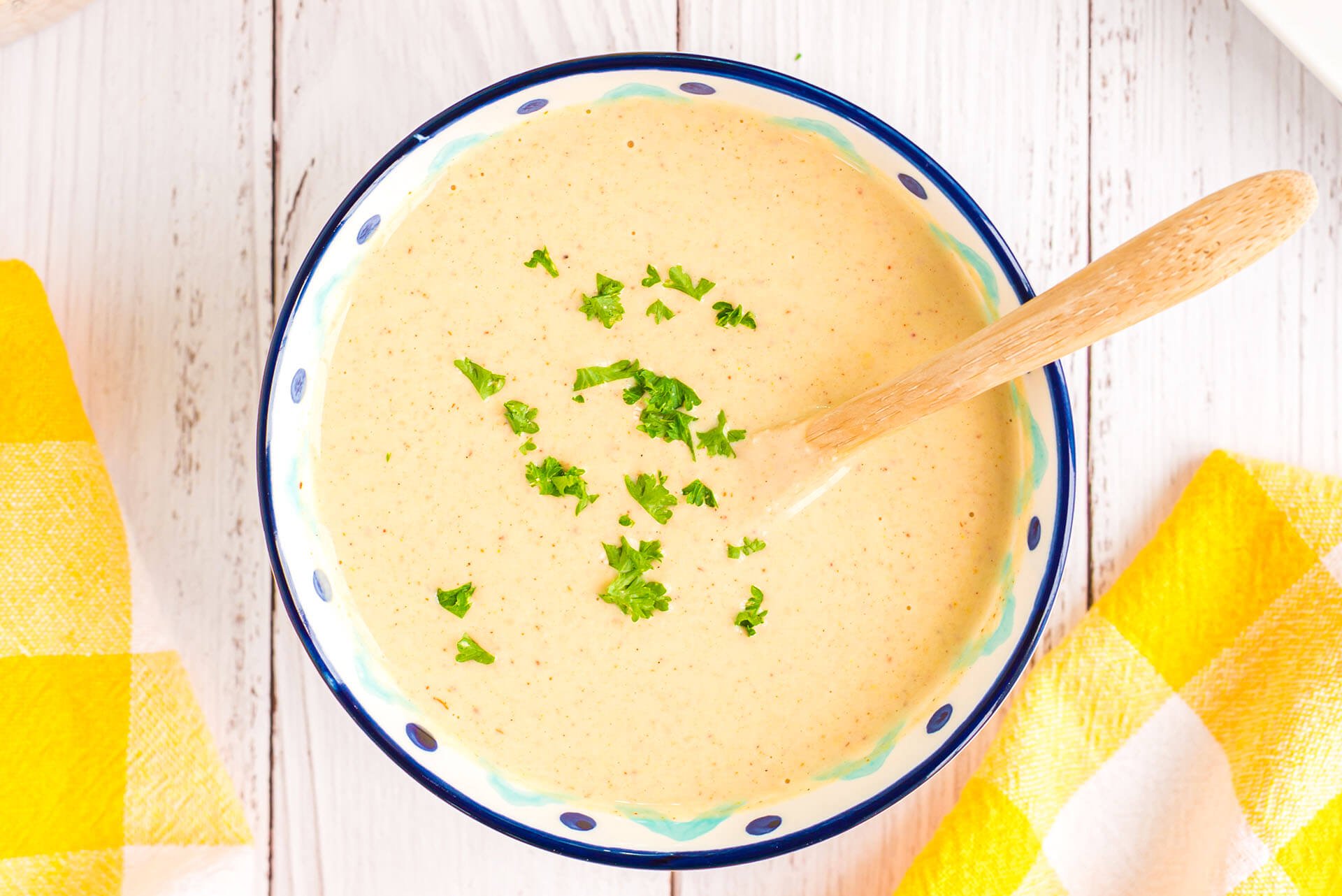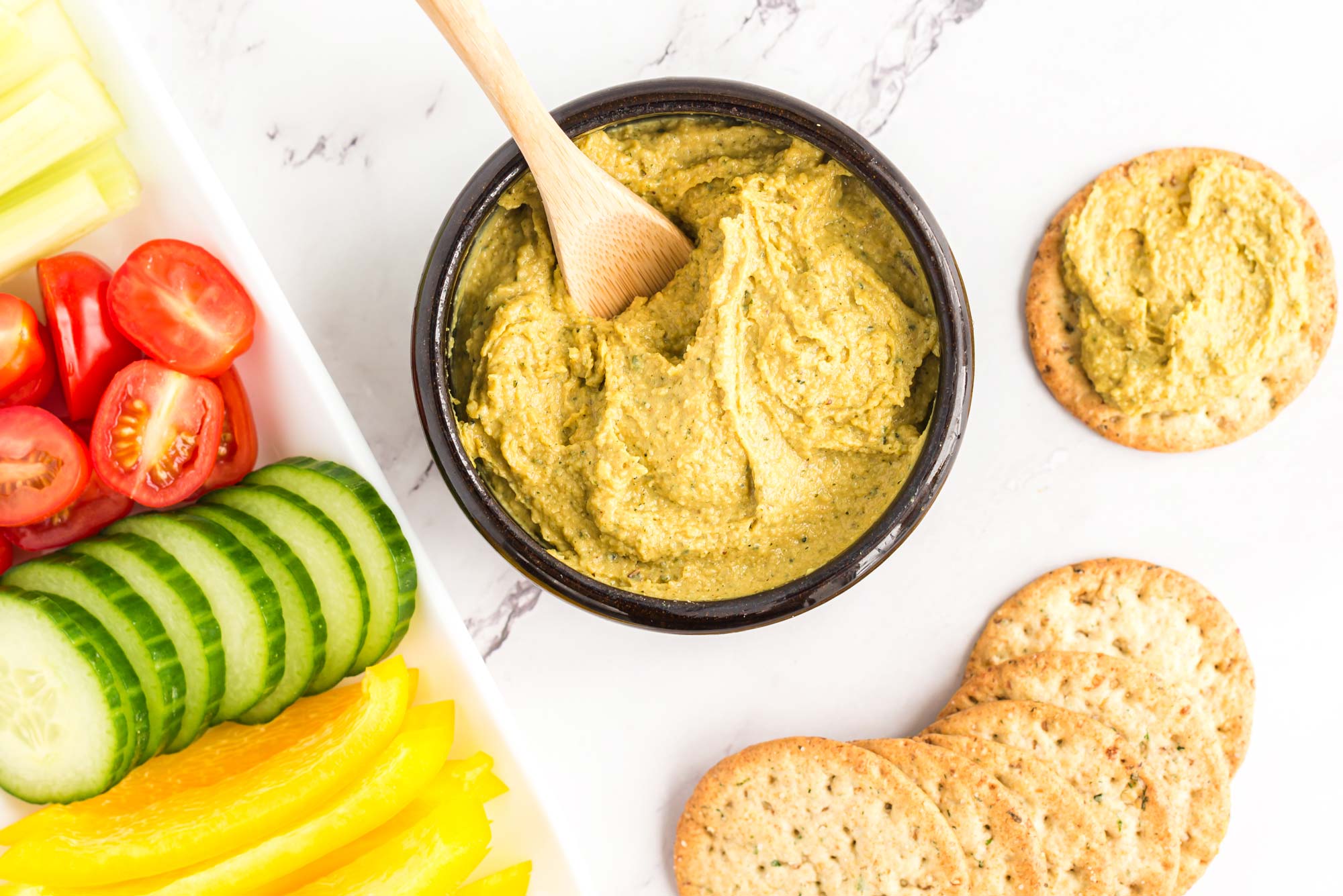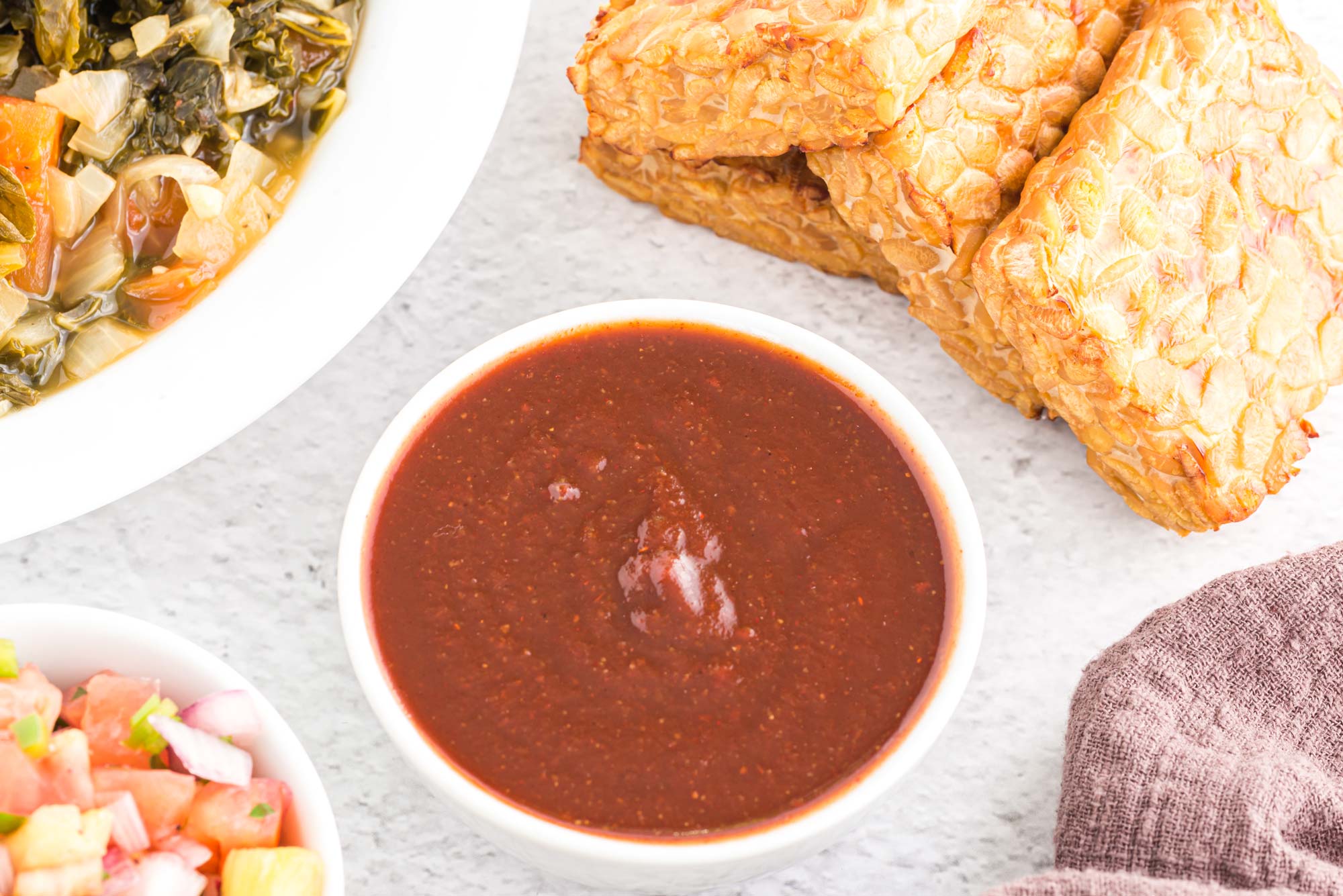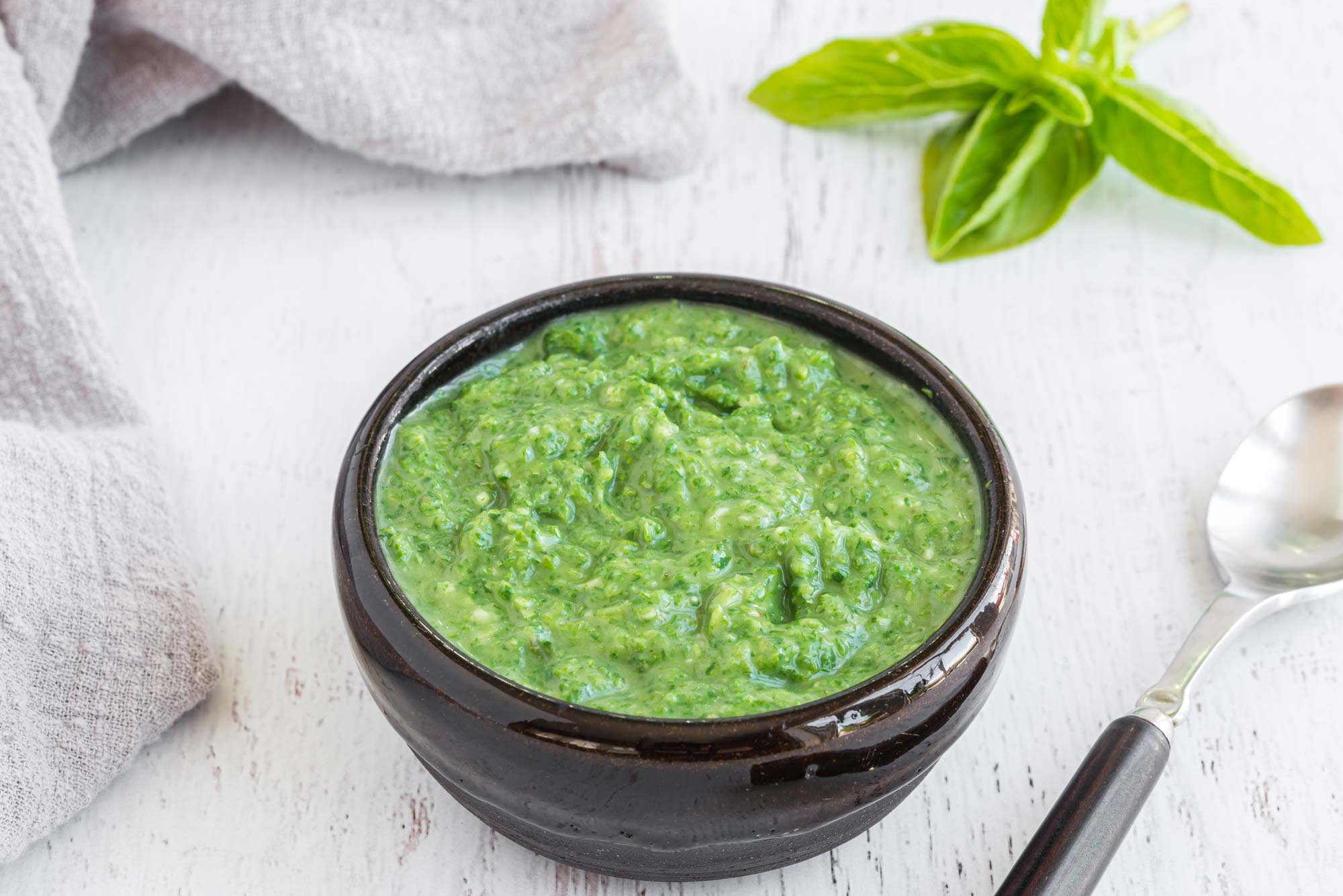In 1964, the US Supreme Court had to decide whether the state of Ohio could ban the showing of Louis Malle’s movie The Lovers on the grounds that it was pornographic. Justice Potter Stewart, writing to strike down the ban, admitted that while he couldn’t give a precise definition of obscenity, nevertheless, “I know it when I see it.”
Somewhat similarly, there’s a lot of debate over what foods qualify as “condiments.” Some are pretty obvious: ketchup, mayonnaise, and mustard. But what about dressings? Bacon bits? Hummus? Rather than come up with a condiment definition, definitive condiment list, or file any Supreme Court briefs about it, let’s just say that any spice, sauce, dip, or topping that adds potent flavor or texture to a dish is, for our purposes, a condiment.
Many foods can go either way, depending on how you use them. Add barbecue sauce to a lentil sloppy joe recipe, and it’s an ingredient. Drizzle it on top of an already baked lentil loaf, and voila — a condiment. Top your salad with ranch dressing, and it’s a condiment. Put it in a bowl next to a raw veggie platter, and it’s a dip.
Typically, condiments add strong flavors to dishes. They can be sweet (maple syrup), salty (soy sauce), spicy (sriracha), savory (tartar sauce), or frequently, a combination. All cultures have their own popular condiments. In fact, condiments are often the most emblematic foods representing particular cultures. Think of Cajun hot pepper sauces like Tabasco and Crystal, Indonesian peanut sauce, Japanese miso, and Mexican salsa.
Popular Condiments List
While there are lots of exotic and niche condiments (the Wikipedia entry listed so many that my hand got bored with scrolling before I reached the P’s in an alphabetical list), many of us rely on a short condiments list when we want to amp up our food. In the United States it typically includes:
- Ketchup
- Mayo
- BBQ & steak sauce
- Pancake syrup
- Soy sauce
- Ranch dressing
- Chocolate syrup
- Whipped cream
- Butter
- Margarine
- Teriyaki sauce
- Cheese
The Problem with Most of These Condiments
To be clear, I don’t hold condiments to the same standards of nutritional excellence as other foods. If a condiment is a little high in unhealthy fat or sodium, that may not be a big deal as long as we treat it as a condiment. Which is to say, in small amounts. We all know a person or two who will drown their burgers in ketchup and go through pancake syrup by the cup instead of the tablespoon. That’s not healthy! Condiments can be a bit saltier than our regular foods without causing harm, though only if we consume them in small amounts.
If a condiment is a little high in unhealthy fat or sodium, that may not be a big deal as long as we treat it as a condiment. Which is to say, in small amounts.
And even when we treat condiments as condiments, a lot of them are problematic. Many mayos and dressings are full of GMO ingredients like canola or soybean oil. Some condiments try to pack an extra punch of flavor by including the flavor enhancer MSG, which reportedly can cause headaches, heart palpitations, and nausea in susceptible people. And many are full of so-called “natural flavors,” most of which are far from natural. And they’re deemed safe by the US government via various loopholes that hide the fact that there’s no testing done, and we really have no idea how they’re affecting our health.
Many condiments are shockingly high in added sugar, either as the familiar white crystals or in the form of high fructose corn syrup, which almost always comes from genetically modified corn. They’re also very often high in sodium, which contributes to heart disease. And a lot of conventional condiments are made pretty with harmful artificial food dyes.
A number of the most popular condiments are dairy-based, like shredded cheese, whipped cream, sour cream, creamy dressings, margarine, and butter. Dairy is linked to cancer, heart disease, and many allergies, as well as being fraught with environmental and ethical concerns.
And most store-bought condiments are highly processed, with all the fiber stripped out to intensify the remaining flavors.
Top 10 Healthy Condiments
But fear not! Just because many popular condiments don’t belong in a healthy diet, doesn’t mean you have to eat plain celery sticks or naked tofu dogs. There are plenty of delicious and healthy condiments you can buy. And many of them are actually really easy to make at home, with minimal ingredients and tools.
Here are some healthier condiments that will satisfy your taste buds without damaging the rest of you:
Mustard
Of all the store-bought condiments, mustard is usually the cleanest — with the fewest ingredients. Even a national brand like Heinz offers a decent yellow mustard. Its ingredients include distilled white vinegar (warning: it could come from GMO grains), mustard seed, water, salt, turmeric, natural flavor, and spices. The only red flag here, other than possible GMOs in the vinegar, is the “natural flavor.” And, good news here, Heinz organic version of its yellow mustard is non-GMO and natural flavor-free.
Look for mustards that are colored with turmeric rather than food dyes (not only are food dyes problematic, turmeric is a pretty amazing superfood). Whole grain mustards use whole mustard seeds rather than ground powder — an extra bonus. And make sure the manufacturer hasn’t added sugar or other flavorings.
Hot Sauce
Most hot sauces, like mustards, contain a few key ingredients like peppers, vinegar, and salt. Vinegar can be healthy (aim for organic or non-GMO certified), and hot peppers can aid digestion, contribute to healthy gut bacteria, and are even associated with longer life expectancy.
When choosing a hot sauce, watch out for excess sodium. Tabasco’s original red sauce has just 35 mg of sodium per teaspoon-sized serving, while Louisiana hot sauce delivers 210 mg per serving. But if, like most people, you’re consuming your hot sauce by the splash, or at most by the teaspoon, sodium likely isn’t a huge concern. A little can go a long way, especially with names like Spontaneous Combustion, Belligerent Blaze, and Dave’s Insanity Sauce. (And those are the PG ones!)
Fermented Foods
These add a ton of flavor and are typically high in probiotics and vitamins. Also, they’re less likely to include preservatives, since the fermentation process itself preserves the food. Look for kimchis and sauerkrauts that need refrigeration. And, if possible, buy from local, small-batch producers that get their veggies from the farmers near you. Fermented foods can be very salty, so use them moderately (or make them the salt source in a dish). Again, a little goes a long way with tangy, and especially spicy, fermented foods.
Herbs and Spices
Condiments don’t have to be fancy sauces, of course. Herbs and spices can add new flavors, as well as bring out the flavors already in your food. Researchers found that people enjoyed broccoli much more when flavored with a combination of garlic, onion, pepper, and basil. Fresh or dried thyme leaf is a good friend to beans and lentils. And you can add pop and zest to your steamed carrots, beets, and cauliflower by sprinkling fresh or dried dill just before serving.
Many herbs and spices have powerful health benefits, too, so you can enjoy both their health-enhancing and culinary properties.
Salsa and Tomato Sauce
Tomatoes are an excellent source of biotin, potassium, iron, and zinc. They’re one of the best sources of lycopene, an antioxidant that reduces inflammation as well as conditions related to oxidative stress. And they’re good for heart health, too. So bring on the salsas and tomato sauces!
Classic red salsa, made from tomatoes, onions, and jalapeno peppers, can perk up bean and lentil dishes, as well as anything in the Tex-Mex category. But you can also shake salsa on really simple dishes to turn them into satisfying meals. Pour salsa onto a baked potato or a bowl of steamed greens, to go from bland and boring to ultra-yummy. You can also use salsa as a salad dressing, especially over chunky salads with carrots, bell peppers, red onions, and tomato wedges.
Even regular old tomato sauce can serve as a condiment over baked or air-fried potatoes or sweet potatoes, or on top of a freshly cut bowl of zoodles (zucchini spiralized into noodle shapes). Tomato sauce gets even healthier and more flavorful with the addition of mushrooms, garlic, and basil. For a wild time, toss in some chopped olive and red pepper flakes to create a piquant puttanesca sauce.
You can often find clean and organic salsas and tomato sauces in supermarkets (look for lower sodium and avoid unhealthy oils and dairy, especially in the tomato sauces). And another option is to make your own. That way, you can have it fresh, flavor it exactly to your tastes, and maximize the antioxidants, vitamins, and minerals in your condiments.
Ketchup
While most store-bought ketchup contains a lot of sugar (even in healthy-looking organic ones, sugar is often the second ingredient after tomato paste), you can make your own tangy and sweet, sugar-free version that takes advantage of the synergistic health effects of tomatoes cooked with herbs and spices. If you’re looking for a specific brand, Primal Kitchen makes some pretty delicious sugar-free ketchup.
Tahini
Tahini is a paste made from sesame seeds that’s very popular in Middle Eastern and Mediterranean countries, where it’s used to top falafel, salads, and main dishes. In its classic form, the thick paste is mixed with a combination of water and lemon juice to a runny consistency, then drizzled over just about any savory dish. Thanks to the sesame seeds, it provides iron, calcium, and protein, and is good for heart health. Tahini is a great replacement for fatty and creamy condiments made from processed oils and dairy.
Horseradish
This spicy root can be grated and used to top veggie dishes, casseroles, and stews. It’s not the “mouth-on-fire” spicy you get from hot peppers; instead, it’s more of the “blow your sinuses off” spicy you might be familiar with if you’ve eaten sushi with wasabi paste. Horseradish is a nutritional as well as flavor powerhouse, sporting anti-bacterial and anti-inflammatory properties, as well as being great for gut health. If you’re wondering about its pedigree, horseradish does not, in fact, have any known historical relationship to large hooved mammals. Instead, it belongs to the royal family of brassicas, which includes nutritional superstars like broccoli, Brussels sprouts, kale, and other antioxidant heroes.
Fresh and Frozen Fruit
Why not chop some apples and pears on your veggie or rice salad? Or drizzle the defrosted juice and berries from a bag of frozen raspberries onto a green salad. Fruit gives you sweetness in a healthy package and adds antioxidants, minerals, and fiber. What’s not to love?
Nutritional Yeast
No plant-based list of healthy condiments would be complete without mentioning the terribly-named yet incredibly-delicious nutritional yeast, which comes in either flake or powder form. Nooch, as it’s sometimes called (and what other food has a nickname that adorable?) is high in plant-based protein and B vitamins. And it is frequently deployed as a substitute for cheese. You can mix nooch in a food processor with lightly pan-roasted nuts and seeds (cashews and sunflower do nicely), along with a little salt and some caraway and fennel seed), and end up with a delicious alternative to grated parmesan cheese for Italian dishes.
Healthy Condiment Recipes
If you love mayonnaise or ketchup, you can certainly find store-bought versions much healthier than Hellman’s and Heinz. Look for versions without GMOs, unhealthy oils, sugars, “natural” flavorings. And, in the case of mayonnaise-type products, look for versions made without industrial eggs. Generally, avoid any “diet” versions, as these tend to contain artificial sweeteners and possibly weird thickeners as well. To be extra-safe, look for organic varieties. Or, take matters into your own hands and make your favorite condiments at home using healthy, whole foods. Here are some healthy condiments you can whip up whenever the mood strikes.
Easy Vegan Mayo
This simple, plant-based vegan condiment is mayo and then some. Not only can it be your go-to spread for plant-based burgers, bowls, and sandwiches, but you can also use it as a base for other flavored sauces. Add garlic to make an aioli, jalapeño to make a spicy dip, or curry to make an Indian-inspired spread. The options are endless!
Lemon Tahini Sauce
The nutty tahini combined with lemon and cumin makes for the perfect blend in this sauce that’s so good, it’s almost drinkable (no judgment here)! Add a little more water than what’s listed in the recipe for a delicious salad dressing. Or leave it as is for a flavorful sauce that’s yummy on top of grain bowls, sweet potatoes, or as a dip for veggies.
Garlicky Cheesy Hemp Spread
The nutritional analysis for this cheesy topper is pretty impressive — generous amounts of B vitamins, five grams of fiber per 2-tablespoon serving, with respectable levels of zinc and selenium, as well. Nutritional yeast gives it a cheesy taste, while miso lends an umami flavor. And hemp offers an extra boost in nutrition. Made with only five ingredients, this may be the simplest plant-based “cheese” you’ll ever make!
Vegan BBQ Sauce
Enjoy this sweet and tangy vegan condiment in a sandwich, on top of baked organic tempeh or tofu, or with grilled vegetables. This homemade version tempts your taste buds with a savory blend of spices in nutrient-dense organic tomato paste without excessive sugar.
Mint Chutney
Can condiments be refreshing? This chutney sure is! Made with fresh mint, cilantro, avocado, and lemon, you’re receiving a pleasant blend of nutrients with each tablespoon. This Mint Chutney contains healthy fat from avocado, vitamin C from the greens, and citrus, not to mention plenty of phytonutrients!
Healthy Condiments for the Win
Condiments are a great way to liven up ordinary dishes and meals. By thinking “outside the squeeze bottle,” you can bring fabulous flavors and great textures into your diet without filling yourself with junky ingredients. Healthy condiments can delight your palate and enhance your life!
Tell us in the comments:
- What are your favorite healthy condiments?
- What new condiment do you want to try next? And what will you put it on?
- Are there any unusual condiments that you like?
Feature image: iStock.com/Olesia Shadrina
